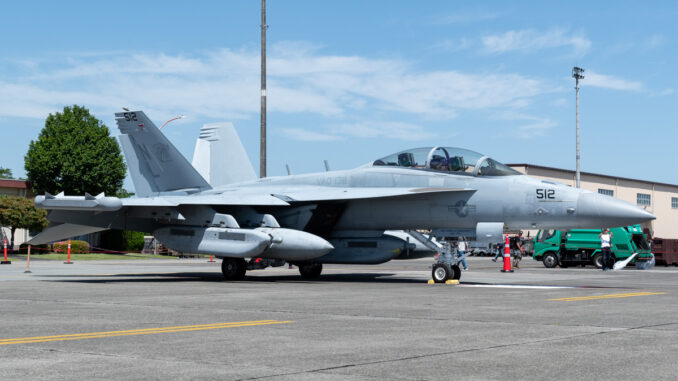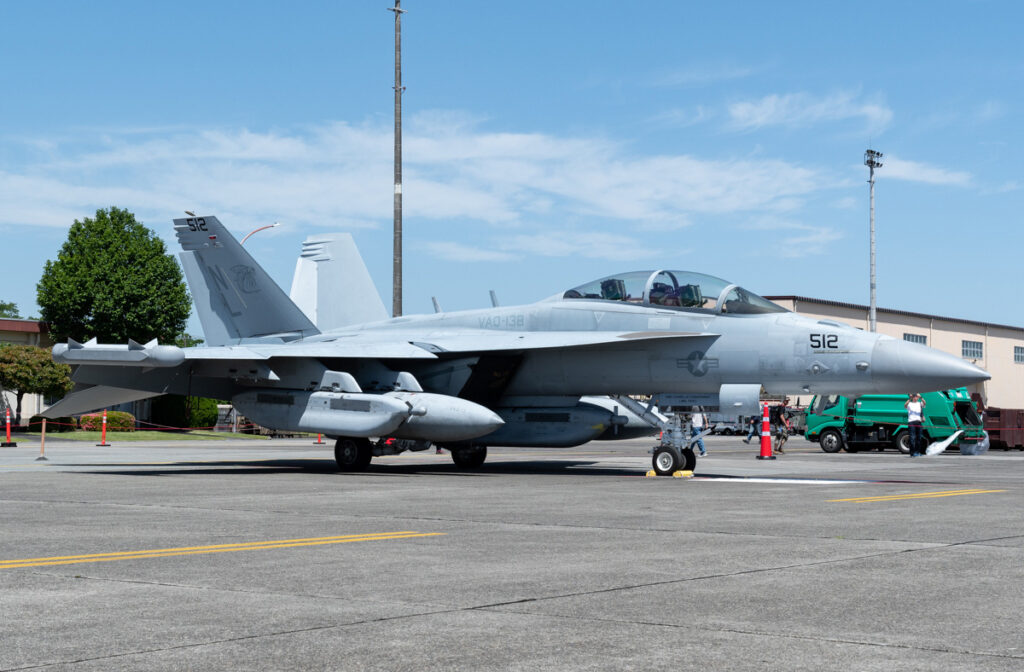
Technical analysis of the Next Generation Jammer (NGJ) on the EA-18G Growler, its electronic warfare capabilities and the future impact of this technology.
Electronic warfare (EW) plays a key role in modern warfare, and the Next Generation Jammer (NGJ) developed by Raytheon for the EA-18G Growler aircraft is a central element of this strategy. This system uses active electronically scanned array (AESA) antennas to interfere with enemy systems, including radar and communications. It protects allied aircraft, such as the Super Hornets, by reducing the range of enemy radars and increasing the attack capability of their weapons. In addition, the NGJ’s autonomous capabilities enable it to cover several targets simultaneously, increasing the effectiveness of offensive electronic warfare missions. This technology could also be integrated into future platforms, such as drones and sixth-generation fighters, adding a new dimension to aerial combat.
The NGJ system and the evolution of offensive electronic warfare
The Next Generation Jammer-Mid Band (NGJ-MB) is one of the most advanced electronic warfare systems, developed for the EA-18G Growler electronic warfare aircraft. This jammer is based on active electronically scanned array (AESA) antennas, which enable electronic attacks to be carried out more effectively and simultaneously. Unlike previous technologies, AESA antennas are capable of handling several targets at once and covering large areas by operating on several fronts, while reducing the probability of being detected.
The NGJ-MB has eight AESA antennas on two pods mounted on the Growler’s wings. This makes it possible to attack targets located to the front, sides and even rear of the aircraft, while continuing to fly in the combat zone. These capabilities are essential for protecting allied aircraft, such as Super Hornets, by rendering enemy radars ineffective and allowing these aircraft to approach enemy targets undetected. In addition, the ability to deal with several targets simultaneously reduces the need to launch a large number of missiles, thereby increasing the depth of the magazine, i.e. the ability to carry out prolonged attacks with a limited number of munitions.
The AESA system is not only useful for electronic warfare, but also improves the capabilities of fire control radars and sensors. This versatility allows aircraft equipped with the NGJ-MB to adopt different techniques depending on the mission, whether it’s an electronic attack or defence against airborne threats.
Impact of the NGJ on the ability to counter enemy missiles
One of the most critical aspects of offensive electronic warfare is the ability to destroy or disrupt enemy missile guidance systems. Although the details of how the NGJ-MB affects missile radars cannot be fully disclosed, it is clear that this technology can alter the ability of enemy radars to locate and track targets. By disrupting the radars of long-range missiles or enemy fighters, the NGJ gives allied forces a decisive advantage in terms of detection and strike.
The NGJ-MB is also capable of reducing the detection range of enemy radars, allowing aircraft to approach targets undetected from very close range. This not only improves the ability of allied forces to launch weapons more accurately, but also reduces the amount of ammunition required to complete a mission. This optimisation of firepower and reduction in ammunition consumption are important strategic advantages in protracted engagements.

Connectivity and cooperation between platforms in the field of electronic warfare
One of the most promising developments in offensive electronic warfare is the ability to connect several platforms via sophisticated communications networks. The NGJ-MB is designed to work in cooperation with other platforms, extending its field of action and increasing its jamming capacity. For example, one unit can assign tasks to another, even if it is hundreds of kilometres away, maximising the overall effectiveness of the system.
The use of multiple techniques on multiple targets is a key feature of the NGJ-MB. The AESA antennas can split their beams to handle multiple targets simultaneously, while switching rapidly from one target to another. This flexibility is crucial in complex warfare environments where multiple threats emerge at different times. By multiplying these capabilities across different platforms, whether fighter aircraft, bombers, UAVs or ships, allied forces can maximise the range and coverage of their electronic attacks, creating a significant advantage in joint operations.
Cooperation between the NGJ-MB and other units also increases the overall electronic attack capability, by spreading efforts over several vectors. In this way, even platforms that are not specialised in electronic warfare, such as bombers, can take advantage of the NGJ’s capabilities to improve the effectiveness of their missions.
Integration of the NGJ into future combat platforms
With the development of sixth-generation fighters and autonomous drones (Collaborative Combat Aircraft or CCA), electronic warfare is set to play an increasingly central role in air conflicts. The NGJ could be adapted to be carried by drones or smaller aircraft. The main challenge lies in the miniaturisation of electronic warfare systems to adapt to platforms with less power and space, while maintaining operational effectiveness.
The NGJ already uses an autonomous power system based on an air turbine that generates 82 kW of power once in flight. This frees the aircraft from the need to supply power to the jammer, increasing the system’s autonomy. In the future, smaller versions of the NGJ could be developed for UAVs, offering electronic warfare capability on more mobile and flexible platforms.
Integrating the NGJ on autonomous UAVs would increase the number of units capable of carrying out electronic attacks, while minimising the risks to human crews. It would also pave the way for longer and more dispersed electronic warfare missions, increasing the strategic depth of allied forces.
Future prospects for offensive electronic warfare
The NGJ represents a major technological leap forward in offensive electronic warfare, but it is only the beginning. As threats evolve, particularly those posed by China and Russia, electronic warfare will become a key area of modern defence. The ability of systems like the NGJ to interfere with enemy communications and radars, while supporting allied platforms, will be essential to maintaining air superiority.
Implementing these technologies on sixth-generation fighters, UAVs and surveillance aircraft would increase the capabilities of allied forces tenfold. Connectivity between the various units, combined with the use of sophisticated jamming techniques, would offer enhanced protection against adversary threats while increasing strike capability.
Finally, investment in technologies such as the NGJ-MB will need to continue in order to maintain a competitive edge in this area. Countries such as China are making rapid progress in the field of electronic warfare, and the United States will have to redouble its efforts to stay ahead in this technological race.
War Wings Daily is an independant magazine.